The following is an excerpt from the book The Cold Start Problem: How to Start and Scale Network Effects by Andrew Chen. Copyright © 2021 by Andrew Chen. Published on Future/ a16z, with permission from Harper Collins, an imprint of HarperCollins Publishers.
A core pillar in the study of network effects is Metcalfe’s Law, where “the systemic value of compatibly communicating devices grows as a square of their number” (to cite one definition). Said plainly, each time a user joins an app with a network behind it, the value of the app is increased to n^2; if a network has 100 nodes and then doubles to 200, its value doesn’t double, it quadruples.
Originally formulated in the 1980s by computer networking pioneer Robert (Bob) Metcalfe, this theory defines the value of a network as a mathematical function based on the number of connected devices — fax machines, telephones, etc. — as it was originally derived from his experiences selling Ethernet. In the late 1990s, it became popular to invoke Metcalfe’s Law in the context of new internet dot-com startups to justify and mark up valuations, suggesting that the value of those startups would explode if one bought in early.
But why should Metcalfe’s Law apply to building internet websites? It doesn’t say much, for instance, about how to think about buyers and sellers on eBay — are those users the same as “compatibly communicating devices”? Is eBay as equivalent to a computer networking technology as Ethernet? But in the excitement of the dot-com boom, it didn’t matter — this “law” was repackaged as the value of a website growing non-linearly as it added users, and became a foundational part of the discussion.
Metcalfe’s Law persists today in discussions of network effects, yet it is not enough for those in the industry who seek to create, scale, and compete using this powerful force. Certainly not for the product managers, engineers, designers, and executives who need to map a strategy around network effects into their upcoming quarterly roadmaps!
From Metcalfe’s Law to… Meerkat’s laws?
Anyone who’s ever actually built a networked product from scratch will tell you that Metcalfe’s Law is painfully irrelevant. Metcalfe’s Law leaves out important phases of building a network, like what you do right at the beginning when no one is using your product.
Nor does it consider the quality of user engagement, and the multi-sidedness of many networks — buyers and sellers, for example. Nor the difference between “active users” versus just people who have signed up, or the degraded experience of a product as too many users start to overcrowd a network. This goes far beyond the simple model of “more nodes is better”; Metcalfe’s Law fails the test of real-life messiness. So what’s better?
It starts with the study of meerkats – yes! — you may have seen one, Timon, in the movie The Lion King, along with his friend Pumbaa the warthog. Meerkats are hypersocial animals in the southern part of Africa, and when they live together in groups of 30-50 animals, they’re called “mobs” or “gangs”. Meerkats like to hang out in a gang because if one of them sees a predator approaching, they stand up on their two little hind legs and vocalize a complex set of predatory alarm calls to alert the group. They will bark or whistle to indicate if an aerial or terrestrial predator is nearby; and if that predator is low, medium, or high urgency… helping keep the group safe.
There are many types of social animals — like meerkats, sardines, bees, and penguins — that benefit by living together, whether in resisting predators and coordinating hunting to finding mates. More nodes in these networks are better.
However, if for whatever reason the population of these social animals declines, the benefits can quickly go away, making them more susceptible to collapse. But if the population grows too quickly, living in too small a space, then overpopulation negates their advantages — which causes the population to plateau.
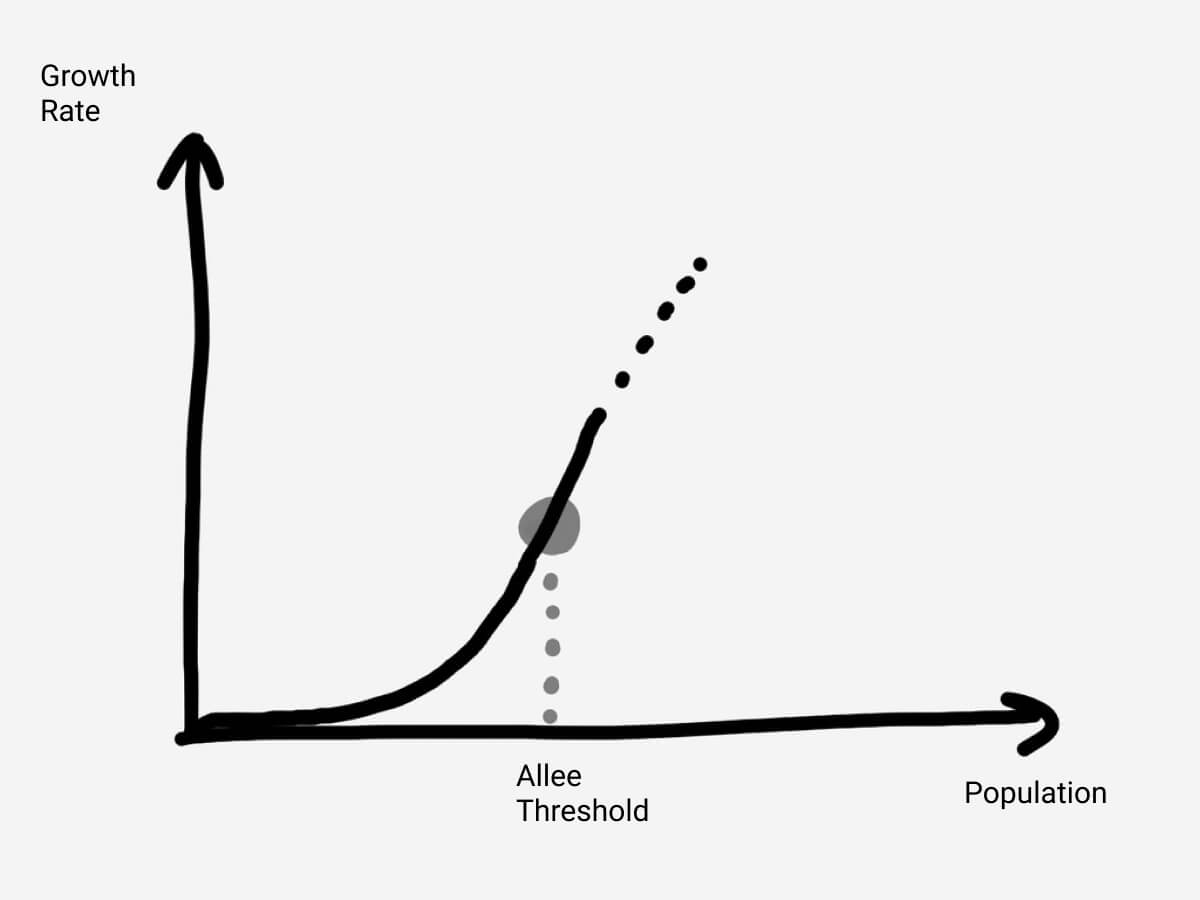
Allee threshold
This became an important concept in biology because it was the first to capture the notion that there was a tipping point — called an “Allee threshold” — where the animals would be safer and thus ultimately grow faster as a population: an ecological network effect.
When there are not enough meerkats in a mob to warn each other of danger, it’s more likely an individual in the mob will get picked off by a predator. After that, it’s a circular dynamic, because with even fewer meerkats, they are even less able to protect themselves, leading to a smaller and smaller population.
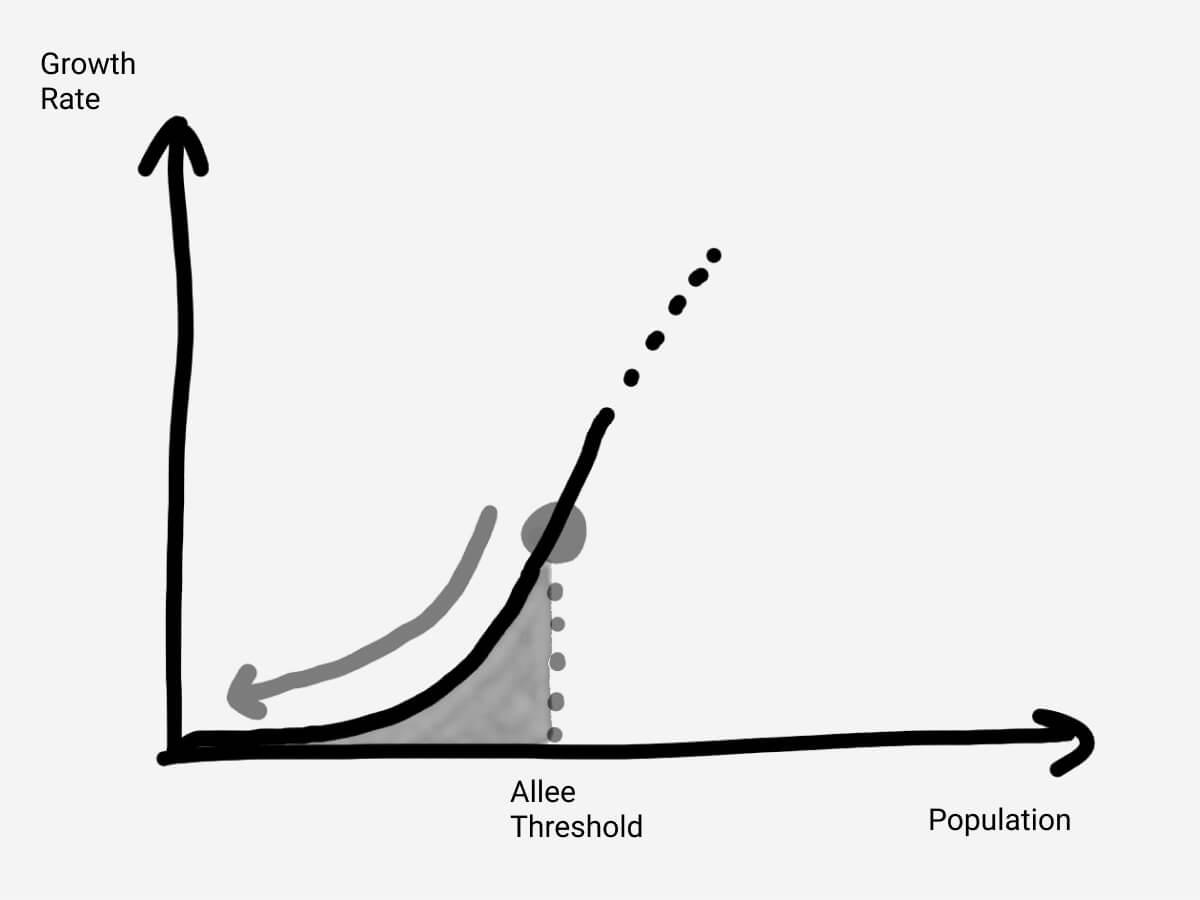
an animal population tends to go toward zero if the Allee threshold isn’t met
The technology product metaphor here is obvious: If a messaging app doesn’t have enough people in it, some users will delete it. And as the user base shrinks, it becomes more likely that each user will leave, ultimately causing inactivity and collapse of the network. (This is what happened to MySpace as Facebook began to take away its users, or when consumers and app developers moved away from BlackBerry and onto Google or Apple smartphones.)
On the other hand, what happens when there’s a nice, healthy mob of meerkats? They keep growing, reproducing, perhaps creating multiple mobs. If you come in above the Allee Threshold, then the population will grow, because the mob is healthy and protected. More meerkats then beget more, and even if predators occasionally pick one or two off, as long as the overall population stays high, it will keep growing.
But that can’t last forever, because there’s only so many resources — like the meerkat favorites of bugs and fruit — to support a finite population. As the population increases, eventually there is a natural limit based on the environment, often called a carrying capacity. For social animals like meerkats and goldfish, overpopulation looks like this, starting flat, then hitting a tipping point before growing quickly past the Allee threshold, and then saturating/ hitting carrying capacity before falling once again:
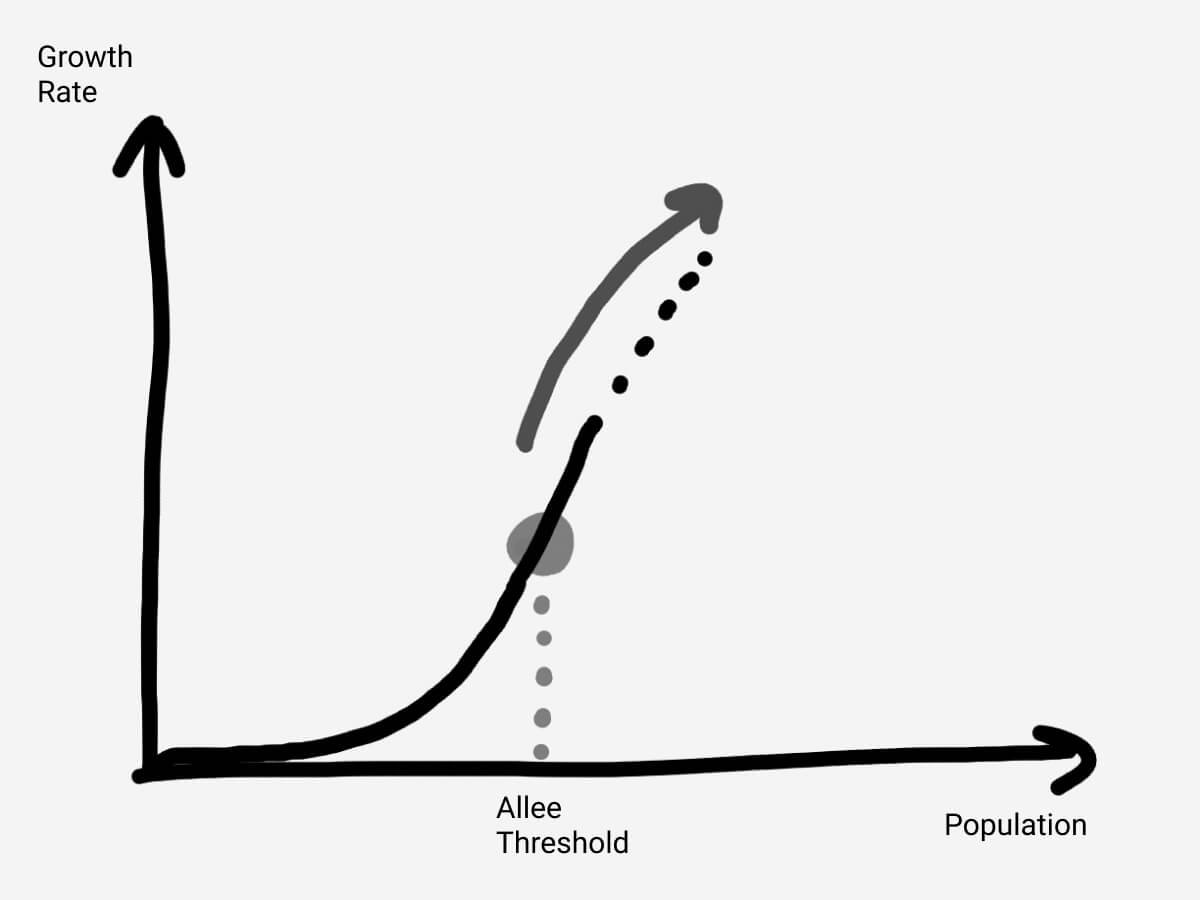
growing past the Allee threshold
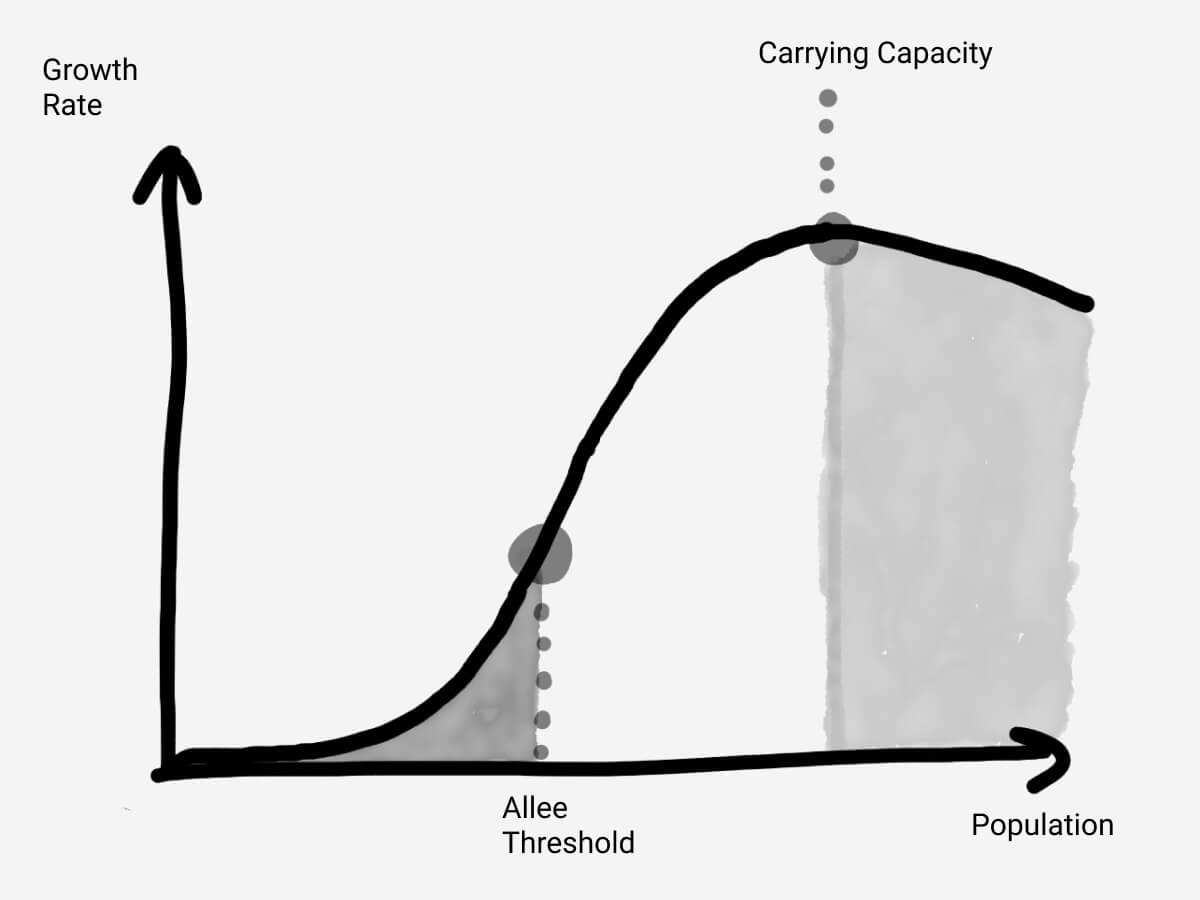
hitting carrying capacity as overpopulation develops
The network effect version of this in the technology industry happens when there’s “overcrowding” from too many users: For communication apps, you might start to get too many messages. For social products, there might be too much content in feeds. Or for marketplaces, too many listings so that finding the right thing becomes a chore.
If you don’t apply spam detection, algorithmic feeds, and other ideas, the network quickly becomes unusable. But add the right features to aid discovery, combat spam, and increase relevance within the UI, and you can increase the carrying capacity for users.
How networks can unwind and collapse
These dynamics were first described in the 1930s by Warder Clyde Allee (hence, the “Allee” curve and threshold), a professor at the University of Chicago and a pioneer of American ecology. His paper with Edith Bowen, “Studies in animal aggregations: Mass protection against colloidal silver among goldfishes”, observed that goldfish grow more rapidly and can resist water toxicity when they are in groups. Just as birds flock together to more easily confuse and resist predators, and mobs of meerkats warn each other of danger, goldfish share the same dynamics.
Allee’s curves are useful in thinking about how networks can unwind and collapse: Crossing the “Allee threshold” is important for a school of fish (or other social animal populations) to switch from being low/negative growth into a self-sustaining population. When you harvest sardines aggressively, for instance, you can push them under the threshold.
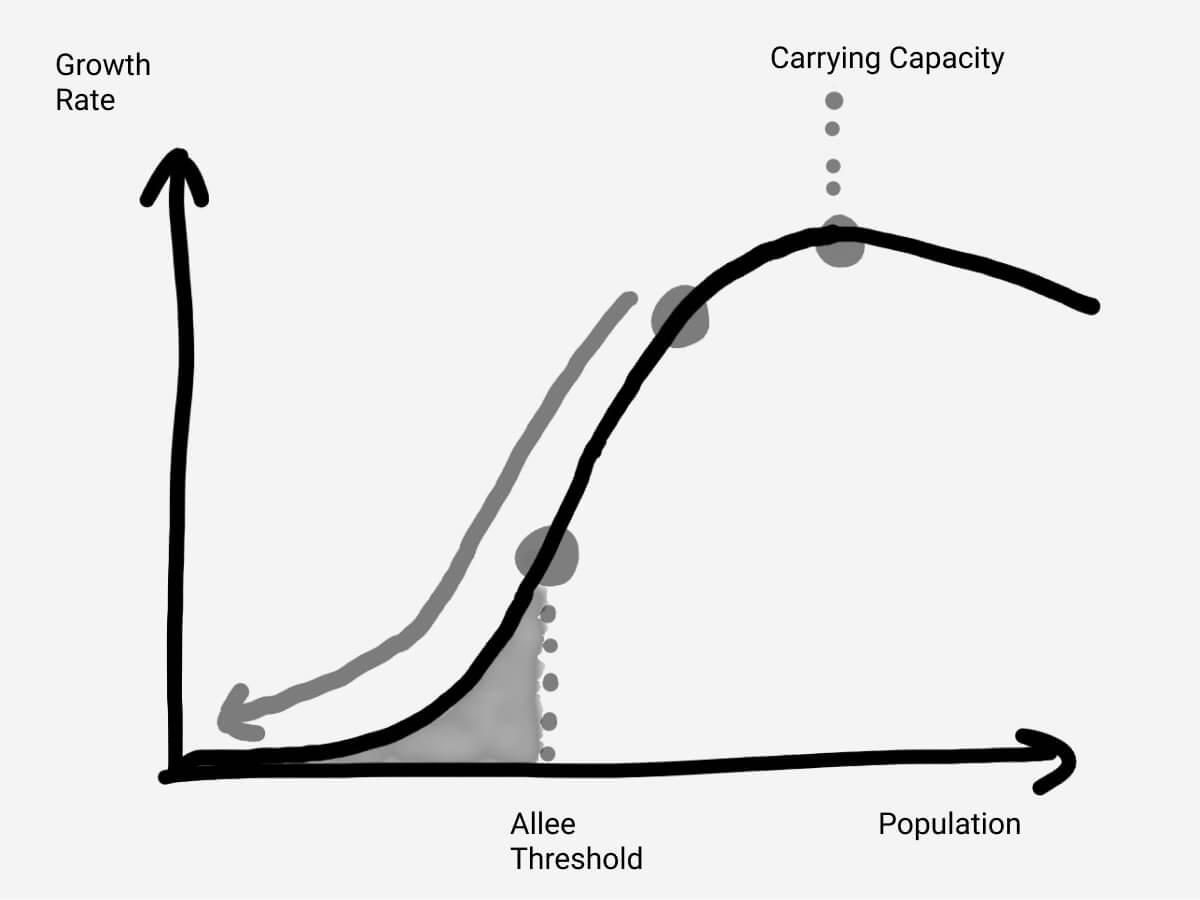
collapsing back past the Allee threshold
Similarly: Why use a texting app that none of your friends are using? Open an empty app enough times, and you’ll quit, too.
When I stood in front of a whiteboard at Uber’s headquarters in San Francisco, trying to visualize how adding more drivers to a city would change the experience for riders, Professor Allee’s ideas on mathematical ecology from college came back to me; the more I thought and sketched, a familiar curve emerged:
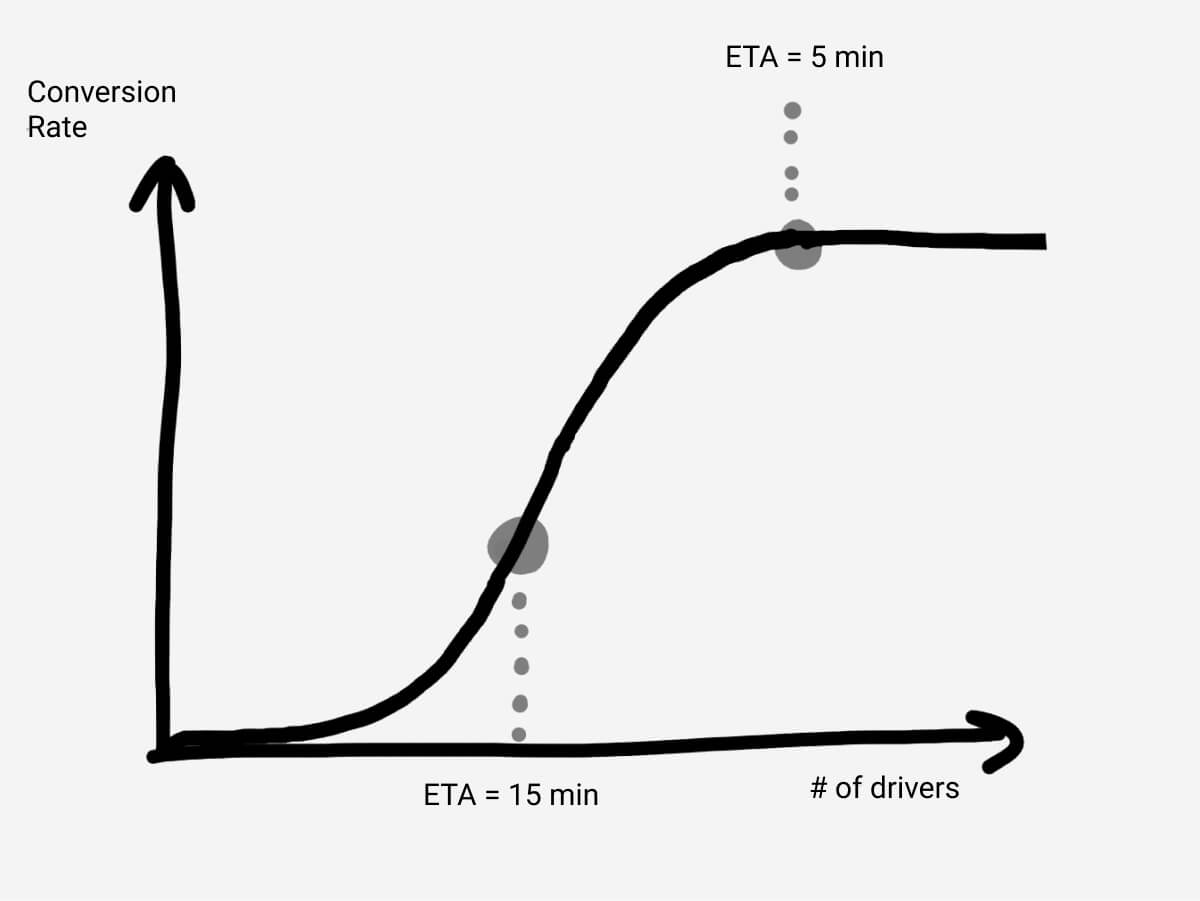
Uber’s conversion rate based on number of drivers
When there are very few drivers in a city, it takes a long time to get a ride (a high ETA or estimated time of arrival). As a result, conversion rates are low, because who has time to wait thirty minutes to get a ride? Thus, until you have a few dozen drivers, the value to the user is nearly zero (and drivers won’t stick around, either, so the entire network will collapse on its own).
Once you pass the tipping point, however, the app becomes somewhat inconvenient but still usable; get it down to 10 minutes or even 5 minutes, then it’s even better. The bigger the network of drivers, the more convenient it gets. The rideshare network in a city starts to see the classic network effect. But eventually, the value of the network plateaus — there’s a diminishing return to having more density of drivers; it doesn’t matter if you can get four minutes versus two minutes versus having a driver instantly outside. In fact, it’s kind of inconvenient, since you need a little time to get your keys and jump out the door to meet your driver.
* * *
The math of meerkats that governs social animals applies to us, too. After all, humans are social animals, connecting with each other by sharing photos, selling collectible sneakers, sharing work projects, and splitting dinner expenses. Rather than hunting and mating, our networks help us with groceries and dating.
Just as a social network needs a minimum number of people on it to become engaging, so too does a mob of meerkats. Just as a messaging app will grow and grow but eventually saturate its market, so too does the growth of animals slow down as they begin to overpopulate their environment.
While the terms are different, the core concepts, and the math, are the same:
- the Allee effect → the network effect
- Allee threshold → tipping point
- carrying capacity → saturation
I may use the vocabulary of business here — network effects, tipping points, and market saturation — but I credit the ecologists like Professor Allee who have created animal population models, for centuries, to predict how fast those grow, when they become overpopulated, and predict their complex dynamics. By borrowing these ideas, we can describe how technology products might launch, scale, and defend markets through network effects.
These ideas offer a richer theoretical foundation than the usual binary notion that technology products either have/ don’t have network effects. The tech industry needs to create a more granular and more precise set of vocabulary to help builders, business leaders, anyone seeking to understand network effects-based platforms get to the next level of analysis, so that concrete concepts and metrics can ultimately be tied to product strategy. What the industry needs is a unified framework that ties together a set of related concepts and vocabulary. This framework is the heart of The Cold Start Problem.


